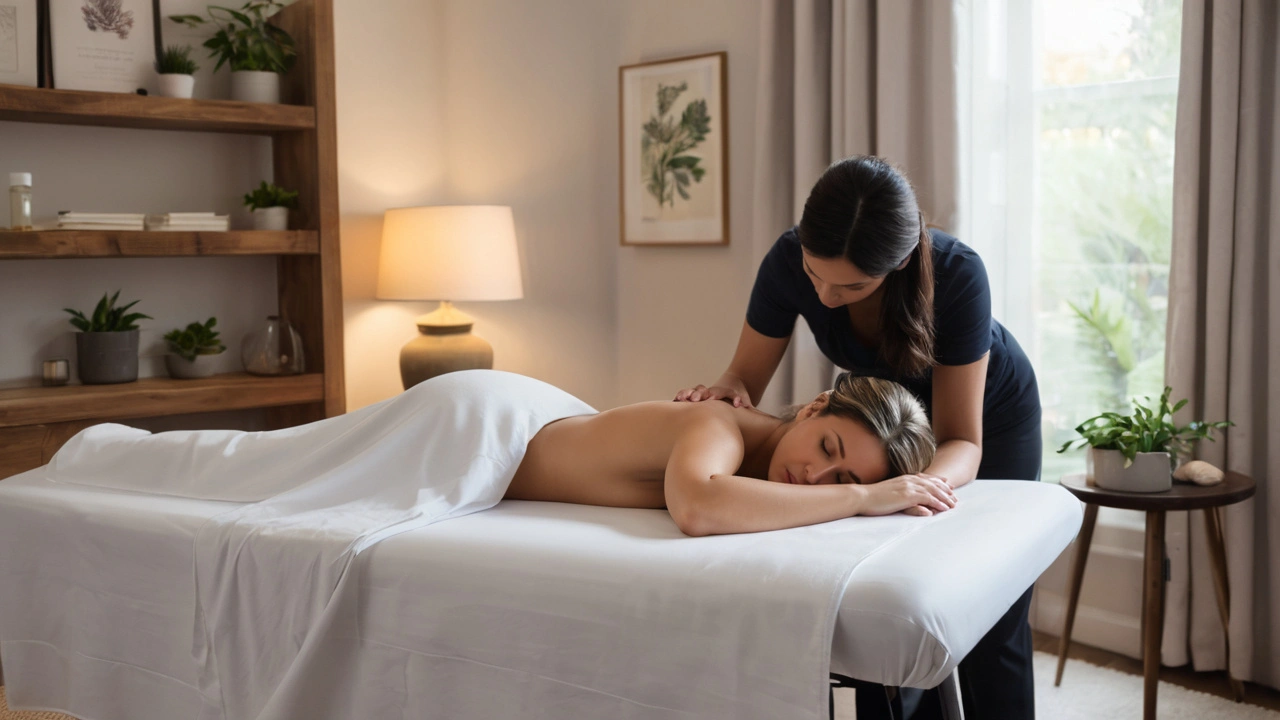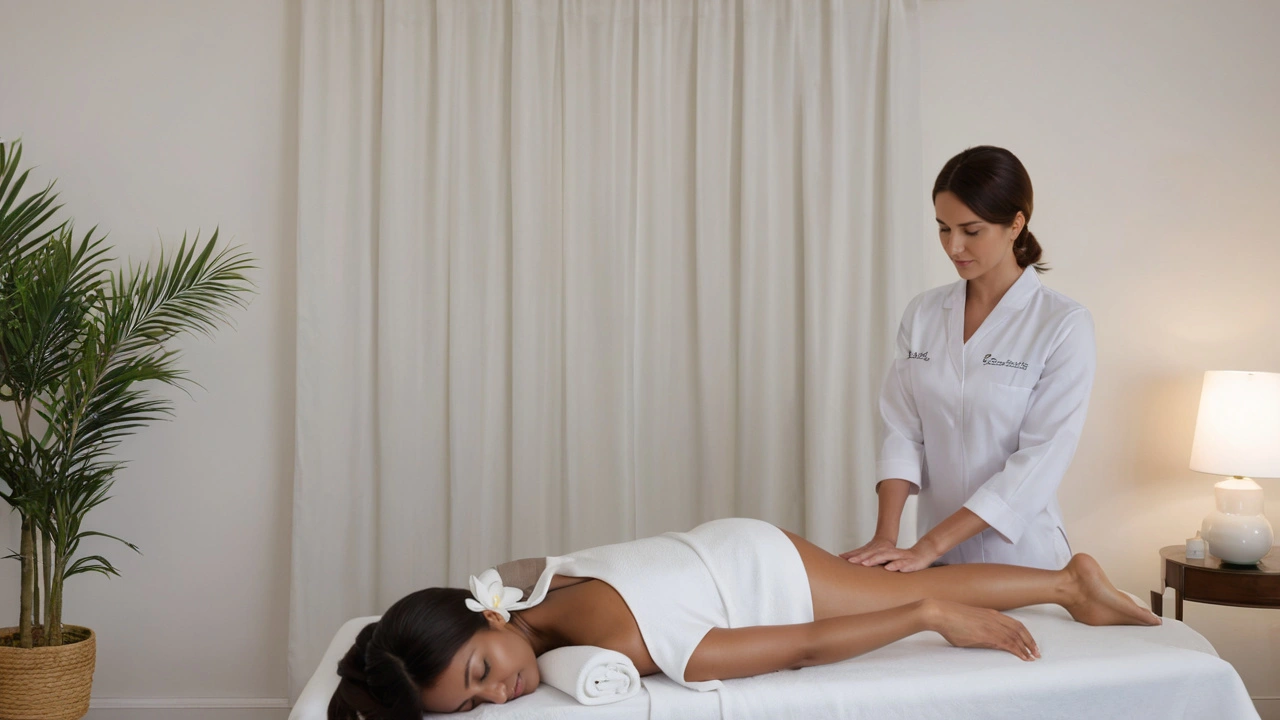Craniosacral Therapy (CST) is gaining attention for its promise of effective pain relief through gentle, non-invasive techniques. Originating from osteopathy, it focuses on the craniosacral system comprising the brain and spinal cord, along with the surrounding membranes and fluid.
The goal is to reduce stress and tensions within this system, which can help alleviate various forms of discomfort. Practitioners use a light touch, no more than the weight of a nickel, to detect and correct imbalances in the craniosacral rhythm.
Many find CST particularly helpful for conditions that are resistant to traditional treatments. From chronic pain to stress-related disorders, this alternative therapy offers a unique approach to healing and well-being.
- Understanding Craniosacral Therapy
- Scientific Basis and Mechanisms
- Benefits of Craniosacral Therapy
- What to Expect in a Session
- Tips for Choosing a Practitioner
Understanding Craniosacral Therapy
At its core, Craniosacral Therapy (CST) is a gentle, hands-on approach aimed at enhancing the body's natural capacity for self-healing. It was developed in the 1970s by Dr. John Upledger, an osteopathic physician, who observed rhythmic motions of the craniosacral system during spinal surgeries. These motions, he believed, were critical to the health of the central nervous system and the entire body.
The craniosacral system includes the membranes and cerebrospinal fluid that surround and protect the brain and spinal cord. CST practitioners use a light touch, often as gentle as five grams, to evaluate and improve the functioning of this system. By releasing restrictions in the craniosacral system, they aim to improve the health and function of the central nervous system.
CST is distinct from other therapies due to its focus on the craniosacral rhythm, a subtle pulsation thought to flow within the dura mater, a tough outer membrane of the brain. In a typical session, the therapist will place their hands on the client's body and 'listen' to these rhythms to locate areas of dysfunction. The light touch used in CST is thought to allow practitioners to feel these subtle movements, which are akin to a very faint heartbeat.
During a session, a practitioner might focus on areas like the skull, sacrum (the triangular bone at the base of the spine), and the spinal column. The idea is that by gently manipulating these areas, any blockages or distortions in the craniosacral system can be corrected, promoting the free flow of cerebrospinal fluid. According to advocates, this can have profound effects not only on physical pain but also on emotional and psychological well-being.
One of the most appealing facets of CST is its suitability for people of all ages, from newborns to the elderly. It has been reported to help alleviate a wide range of conditions, including migraines, chronic neck and back pain, stress and tension-related disorders, chronic fatigue, and even post-traumatic stress disorder (PTSD). Some practitioners claim it can also help with conditions like colic in infants and learning difficulties in children.
"Craniosacral Therapy is a powerful approach to improving entire body health and function through the modality of touch and presence." - Dr. John UpledgerCST is less about 'fixing' and more about facilitating the body's natural healing processes. Because of this, many people find it incredibly relaxing and report feelings of deep peace and stillness after a session. While scientific evidence on its efficacy is still developing, anecdotal reports and practitioner experiences provide compelling reasons to explore this therapeutic modality.
Given its holistic approach and the increasing interest in complementary and alternative medicine, CST is carving out a significant niche in the wellness industry. If you're considering trying Craniosacral Therapy, it's essential to find a qualified practitioner who has undergone extensive training in the technique. The Upledger Institute is a reputable organization that offers certifications and training programs worldwide, ensuring that practitioners are well-versed in the principles and practices of CST.
Scientific Basis and Mechanisms
Craniosacral Therapy might sound a bit mystical, but it is grounded in quite a straightforward understanding of the body. The craniosacral system encompasses the membranes and fluids that surround the brain and spinal cord. By gently manipulating this system, practitioners aim to relieve the restrictions in the craniosacral rhythm. This rhythm is a subtle flow of cerebrospinal fluid, which nourishes and protects the brain and spinal cord.
The science behind CST is based on the idea that this rhythm can be felt throughout the body, not just in the head and spine. Practitioners use a very light touch—no more than five grams of pressure—to feel for these movements. They believe that disruptions in this rhythm can lead to a range of health issues, from migraines to chronic pain. By restoring the natural flow of cerebrospinal fluid, they aim to help the body heal itself.
Dr. John Upledger, an osteopathic physician, was one of the key figures who advanced the study and practice of Craniosacral Therapy in the 1970s. He conducted detailed research that supported the idea of the craniosacral system having a significant influence on overall health. According to Upledger, “Every cell knows how to heal itself; the complexity is getting the cells to communicate with each other about their needs.”
The body’s ability to self-correct is a cornerstone of CST. When the practitioner applies those gentle touches, they are not forcefully realigning anything. Instead, they are subtly guiding the body’s own healing mechanisms. This gentle guidance can be particularly effective for those who have sensitivities or conditions that make them intolerant of more aggressive treatments.
One notable aspect of CST is how it emphasizes the interconnectivity of bodily systems. By relaxing tension in the craniosacral system, there can be a ripple effect to other parts of the body. For instance, loosening tight cranial membranes can potentially ease tension in the neck or even the lower back. This holistic approach can make CST a valuable addition to other forms of healthcare by fostering a more integrated healing process.
Many practitioners and patients report feeling a deep sense of relaxation and relief during and after CST sessions. While the movements and adjustments are subtle, the impact can be profound. Given its gentle nature, CST is often considered safe for people of all ages, from infants to the elderly. This makes it a versatile option for those seeking a non-invasive way to manage pain and stress.
Though more research is needed to fully understand the mechanisms at play, preliminary studies and anecdotal evidence suggest a promising future for CST in the broader field of pain management and holistic health. The therapy provides an exciting blend of traditional wisdom and modern science, with the potential to offer solutions where conventional methods may fall short.

Benefits of Craniosacral Therapy
The appeal of Craniosacral Therapy (CST) lies in its broad range of benefits that cater to various health needs. One of the primary advantages is pain relief. Individuals suffering from chronic pain conditions, such as fibromyalgia and migraines, have reported significant improvements after undergoing CST. This is achieved through gentle manipulations that help relax the central nervous system, allowing the body to self-heal more effectively.
Another key benefit is its impact on stress and anxiety. In today’s fast-paced world, mental health challenges are becoming more prevalent. CST offers a holistic approach to address these concerns. By focusing on the craniosacral system, the therapy promotes deep relaxation, which can lead to reduced stress levels and decreased anxiety. This is supported by studies showing how soft touch can activate the parasympathetic nervous system, often referred to as the body's 'rest and digest' mode.
"Craniosacral Therapy is like hitting the reset button for your nervous system," says Dr. John Upledger, a pioneer in the field.
Beyond pain and stress relief, CST also supports overall well-being. People who regularly receive this therapy often experience improved sleep, enhanced immune function, and better mental clarity. The therapy’s gentle nature makes it suitable for all ages, from infants to the elderly, providing a non-invasive solution for various health concerns.
Those suffering from post-traumatic stress disorder (PTSD) can also benefit. CST can help release physical and emotional trauma stored within the body. By creating a safe and nurturing environment, therapists allow individuals to process and release these deep-seated issues without the need for speaking about them, offering an alternative route to traditional talk therapy.
The versatility of CST extends to its use in treating temporomandibular joint disorders (TMJ). Many patients report relief from jaw pain and associated headaches after a series of sessions. This is particularly useful for those who have found limited success with other treatment options. Additionally, athletes recovering from injuries often turn to CST as part of their rehabilitation process, finding that it aids in speeding up recovery and preventing future issues.
For those interested in exploring CST, it's worth noting that results can vary. Some people experience immediate relief, while others see gradual improvements over several sessions. It's important to consult with a certified practitioner who can provide a tailored approach to meet your specific health needs.
What to Expect in a Session
When you walk into a session of Craniosacral Therapy (CST), the environment will likely be serene and calming. The therapist will first ask you about your medical history, any chronic pain issues, and what you are aiming to achieve through the therapy. This helps in tailoring the session to your specific needs. Once the initial discussion is over, you will be asked to lie down, typically on a massage table. You remain fully clothed but may be asked to remove shoes and any bulky clothing for comfort.
The therapist will begin with a light touch, usually starting at your head, although some may begin from the base of the spine. They use their hands to feel the craniosacral rhythm, which is a subtle pulse created by the flow of cerebrospinal fluid around your brain and spinal cord. This rhythm helps the therapist detect areas of tension or dysfunction. Their touch is gentle, often described as no heavier than the weight of a nickel.
As the session progresses, you might feel various sensations—these can include warmth, tingling, or even subtle pulsations. These sensations are normal and indicate that the therapy is having an effect. The therapist may move their hands to different parts of your body, such as your spine, sacrum, or even your feet, always maintaining that gentle touch. The session usually lasts about an hour, although the duration can vary depending on your individual needs.
Many people feel a deep sense of relaxation during and after a CST session. Some even report immediate pain relief or a reduction in their symptoms. However, results can vary, and it may take several sessions to achieve noticeable improvement. Some therapists incorporate complementary techniques such as guided visualization or soft tissue manipulation to enhance the effects of the therapy.
According to Dr. John Upledger, a pioneer in CST, “This therapy can tap into the body’s natural ability to heal itself, promoting overall well-being and enhanced function.”It's not uncommon to feel more emotional or physically different after a session. This is often a sign that your body is adjusting to the changes brought about by the therapy. Drinking plenty of water and getting adequate rest can help facilitate these changes.
Before you leave, the therapist might offer some practical tips for maintaining the benefits of the session. These can include simple stretches, mindfulness exercises, or even dietary suggestions to support your overall health. Scheduling follow-up sessions is often recommended, especially if you are dealing with chronic issues.

Tips for Choosing a Practitioner
Selecting the right practitioner for Craniosacral Therapy is crucial to ensure you receive the full benefits of this gentle healing technique. Here are some practical tips to help you find a qualified and trustworthy CST practitioner.
First and foremost, check for proper certification and training. While Craniosacral Therapy is a non-invasive technique, it still requires skilled hands. Look for practitioners who have been trained through reputable organizations such as the Upledger Institute, which offers comprehensive programs in CST. Certified practitioners typically display their credentials in their offices or on their websites.
Experience is another essential factor. Although it might be tempting to give a new practitioner a chance, experience can often translate to better skill and understanding of the technique. Don't hesitate to ask how long they have been practicing CST and inquire about their specific experience with conditions similar to yours. A seasoned practitioner is likely to adjust their techniques based on your unique needs.
Ask for recommendations and read reviews. Personal recommendations from friends, family, or healthcare providers can be incredibly valuable. Additionally, don't underestimate the power of online reviews. Websites like Yelp, Google Reviews, or even specific alternative medicine forums can provide insights into other patients' experiences.
Make sure you feel comfortable with the practitioner. The relationship between patient and practitioner is crucial for any healing process. During your initial consultation, assess how the practitioner communicates with you. Are they patient, attentive, and empathetic? Do they take the time to explain the procedure and address your concerns? Comfort and trust are vital for a successful CST session.
Observe the environment in which they practice. A clean, calm, and welcoming environment can enhance your therapy experience. Notice the general ambiance of the clinic, the demeanor of the staff, and the level of privacy you are afforded. These factors can greatly impact your comfort and relaxation during sessions.
Look into the cost and availability. While cost should not be the sole deciding factor, it's essential to find a practitioner whose fees fit within your budget. CST is often categorized under alternative medicine, so it's a good idea to check if your health insurance covers it. Additionally, consider the practitioner's availability and location. Consistency is key in Craniosacral Therapy, so ensuring you can attend sessions regularly without much hassle is important.
Consider seeking a consultation before committing. Many practitioners offer an initial consultation at a reduced rate or even for free. This meeting allows you to gauge if their approach and personality align with your needs. It can also be a good opportunity to ask more detailed questions about the therapy and their methods.
Ask about additional services offered by the practitioner. Some CST practitioners may have training in other complementary therapies, such as massage therapy, acupuncture, or chiropractic care. Depending on your health situation, a multi-disciplinary approach may provide better overall results.
Lastly, trust your instincts. Your intuition can be a powerful guide when selecting a healthcare provider. If something doesn’t feel right during your initial meetings or sessions, don’t be afraid to explore other options. Your comfort and confidence in the practitioner are essential for the effectiveness of the therapy.
Selecting the right Craniosacral Therapy practitioner is a personal journey. By following these tips, you can increase your chances of finding someone who not only has the right qualifications but also makes you feel comfortable and confident in your healing journey.

